Badminton Buzz
What sport is lightning-fast, super fun for spectators, wildly popular around the world and finally making its niche in Hawaii? Drum rollll ... Badminton!

By .(JavaScript must be enabled to view this email address)
E-mail this story | Print this page | Archive | RSS

|
 |
What sport is lightning-fast, super fun for spectators, wildly popular around the world and finally making its niche in Hawaii? Drum rollll ... Badminton!
"If you talk about level, like the NBA, and compare it to world international badminton players, our jaws would drop, our eyes would pop out," says Alan Teoh, a 75-year-old player who’s been a core member of the Hawaii badminton scene since its inception in the late 1970s. "Badminton is so fast — a smash is 250 miles per hour! In Korea, they show on TV a guy smashing the bird through a watermelon." True to his word, a quick look at http://www.xbadmintontricks.com shows a shuttlecock ripping through the air, planting itself straight into the melon’s thick rind.
"Most Americans don’t understand the game — they think it’s a backyard game. It’s actually the second most popular sport in the world, after soccer," says Robin Lyons, founder of Hawaii’s annual badminton tournaments. "In Asian countries you have 30,000-40,000 people come and pay hundreds of dollars to watch the matches, like we do with football here. In Europe it’s big too."
Lyons, originally from Canada, is the one credited with starting badminton tournaments on Oahu. With his help, the Hawaii Badminton Club has grown from its humble beginnings with a dedicated group of about 12 players to a major destination for badminton enthusiasts. The Jan. 1-3, 2011, Honolulu Open featured 135 entries, ages 13 to 70-plus, resulting in more than 300 matches. The courts at UH Manoa were abuzz with local and Neighbor Island players, as well as players from Canada, Shanghai, France and the Mainland. Mayor Peter Carlisle even took to the courts to join in the fun.
Fifty more top-level players were expected from China, which would have been the biggest contingency of Chinese players at any U.S. tournament, said club president Andy Tanabe. When their visas fell through, Tanabe was thanking the gods of organization for the puka. His biggest flaw in his first year at the helm was being a bit too organized. Normally the planning is a one-person feat, but to make it manageable, Tanabe organized a committee.
"(Because of the committee’s efficiency) the tournament was 50 percent bigger than last year. If you organize it, they will come," laughs Tanabe.
So what’s the game’s big draw? Several local players sound off on the finer aspects of badminton:
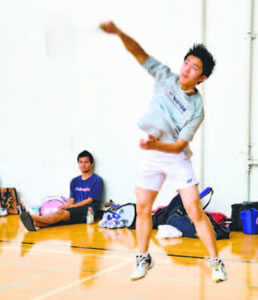
|
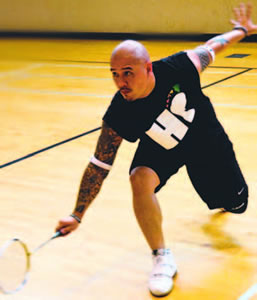 |
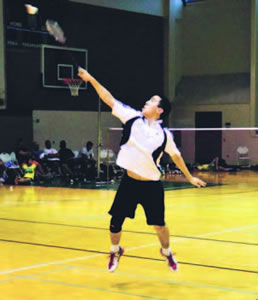 |
 |
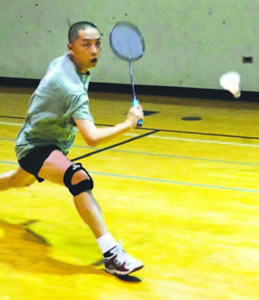 |
 |
Andy Tanabe: Because of my small size — 5-foot-2, 112 pounds — I could really never play football or basketball, so there was not a lot of great self-image that I had. When I went to university I took a PE class and I said, wow, (badminton) is a sport that the little guy can handle because it’s not a heavy racket, not like tennis. It’s a great sport because of the speed of the birds. You really don’t have time to think about anything else but just focusing on the bird, so the endorphins you get by playing can be very mentally and physically refreshing. It’s one of the most demanding sports for physical endurance. When I practice on a normal practice night, it’s the equivalent of jogging 15 miles at 8 minutes per mile.
Robin Lyons: In the middle of a tournament, a tennis player looked in and said, ‘Oh, is this a slower version of tennis?’ and I said, ‘No this is much faster than tennis.‘In tennis you can let the ball bounce, here you can’t. People watch tennis all the time, but when you watch badminton, tennis becomes very boring. People are at the back line hitting it under-hand, whereas here most of the offensive shots are over-hand.
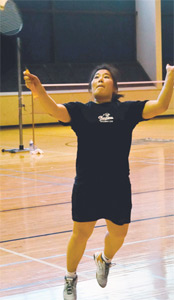
|
Another thing, badminton is one of those things you can play all your life. I’m going to be 70 next year.
Alan Teoh: When I went to play in the U.S. National tournament on the Mainland, I met players who were 92 and 93. So I’m a young one at 75. I have 20 more years I can play. I went to Australia for the big one, the 2009 World Masters Games. I entered in three events for my age group 70-75 — men’s doubles, mixed doubles and the team event. I won three golds, and you know, I had open heart bypass surgery 15 years ago.
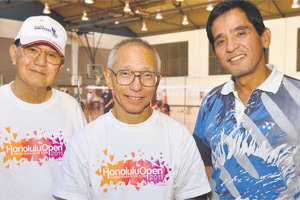
|
Bob Kishi (former HBC president): The thing about badminton is it’s such a social sport. When we play on a weekly basis, we have a lot of fun talking to each other. You can talk to your partner, talk to the person across the court. There’s a lot of joking around. Also you don’t all have to be at the same level of play in a match. You can have a person who’s an A level player team up with a C level player, and the other team can have two B players. That would be pretty even, whereas in other sports that’s hard to do. Also, even the older players can compete against the younger ones if the older player is highly skilled. He can overcome speed and power with the placement of shots and the type of shots he makes. And the rallies last longer. With tennis, it’s just a few shots, but badminton can go 30-40 shots for just one point.
Dr. Lloyd Hisaka (director of student recreational services at UH): Badminton is a great recreational game. I used to play a lot of tennis before, and you need to find someone of comparable ability, otherwise you’re spending most of your time chasing the ball. The shuttle lands and it just stays there. You don’t have to go chase the ball to the corner of the court.

|
Hisaka got involved with the Badminton Club a year ago, after vandals flooded the Aiea gym where the club normally hosted its tournaments. UH pulled through in the emergency, offering a larger court space (six nets, rather than Aiea’s three) and offering visiting players a location closer to their Waikiki hotel rooms. Hisaka says the gym is open two nights a week to students for recreational badminton. UH also offers badminton as part of its Leisure Programs, with Tanabe teaching two classes a semester. Anyone can sign up for the classes, with non-students paying a slightly higher rate. Tanabe also teaches classes at Aiea District Park, attracting players of all ages and especially high school students.
“A lot of people have a natural style that is not conducive (to playing badminton). In training, we tell them how to place your foot so you don’t break your ankle, how to run so that you don’t injure yourself,” explains Tanabe. “A lot of injuries happen because people think it’s too simple. When the matches start getting fast, if you train to move mechanically properly, you’ll be injury free. You can then build up your efficiency in speed. You need to be smooth and flowing on the footwork and if you see some of the higher level matches, you’ll see the movement that they have - it’s kind of like great athletic dancing.”
For more information, call 366-8680 or visit hawaiibc.org.
Page 1 of 1 pages for this story
E-mail this story | Print this page | Comments (0) | Archive | RSS
Most Recent Comment(s):








